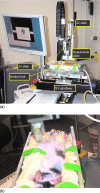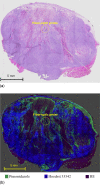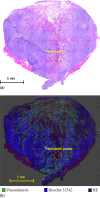A robotic system for 18F-FMISO PET-guided intratumoral pO2 measurements
- PMID: 19994538
- PMCID: PMC2776816
- DOI: 10.1118/1.3239491
A robotic system for 18F-FMISO PET-guided intratumoral pO2 measurements
Abstract
An image-guided robotic system was used to measure the oxygen tension (pO2) in rodent tumor xenografts using interstitial probes guided by tumor hypoxia PET images. Rats with approximately 1 cm diameter tumors were anesthetized and immobilized in a custom-fabricated whole-body mold. Imaging was performed using a dedicated small-animal PET scanner (R4 or Focus 120 microPET) approximately 2 h after the injection of the hypoxia tracer 18F-fluoromisonidazole (18F-FMISO). The coordinate systems of the robot and PET were registered based on fiducial markers in the rodent bed visible on the PET images. Guided by the 3D microPET image set, measurements were performed at various locations in the tumor and compared to the corresponding 18F-FMISO image intensity at the respective measurement points. Experiments were performed on four tumor-bearing rats with 4 (86), 3 (80), 7 (162), and 8 (235) measurement tracks (points) for each experiment. The 18F-FMISO image intensities were inversely correlated with the measured pO2, with a Pearson coefficient ranging from -0.14 to -0.97 for the 22 measurement tracks. The cumulative scatterplots of pO2 versus image intensity yielded a hyperbolic relationship, with correlation coefficients of 0.52, 0.48, 0.64, and 0.73, respectively, for the four tumors. In conclusion, PET image-guided pO2 measurement is feasible with this robot system and, more generally, this system will permit point-by-point comparison of physiological probe measurements and image voxel values as a means of validating molecularly targeted radiotracers. Although the overall data fitting suggested that 18F-FMISO may be an effective hypoxia marker, the use of static 18F-FMISO PET postinjection scans to guide radiotherapy might be problematic due to the observed high variation in some individual data pairs from the fitted curve, indicating potential temporal fluctuation of oxygen tension in individual voxels or possible suboptimal imaging time postadministration of hypoxia-related trapping of 18F-FMISO.
Figures





Similar articles
-
Image-guided PO2 probe measurements correlated with parametric images derived from 18F-fluoromisonidazole small-animal PET data in rats.J Nucl Med. 2012 Oct;53(10):1608-15. doi: 10.2967/jnumed.112.103523. Epub 2012 Aug 29. J Nucl Med. 2012. PMID: 22933821 Free PMC article.
-
Assessment of regional tumor hypoxia using 18F-fluoromisonidazole and 64Cu(II)-diacetyl-bis(N4-methylthiosemicarbazone) positron emission tomography: Comparative study featuring microPET imaging, Po2 probe measurement, autoradiography, and fluorescent microscopy in the R3327-AT and FaDu rat tumor models.Int J Radiat Oncol Biol Phys. 2005 Apr 1;61(5):1493-502. doi: 10.1016/j.ijrobp.2004.12.057. Int J Radiat Oncol Biol Phys. 2005. PMID: 15817355
-
Animal-specific positioning molds for registration of repeat imaging studies: comparative microPET imaging of F18-labeled fluoro-deoxyglucose and fluoro-misonidazole in rodent tumors.Nucl Med Biol. 2006 Jan;33(1):65-70. doi: 10.1016/j.nucmedbio.2005.07.011. Nucl Med Biol. 2006. PMID: 16459260
-
FMISO as a Biomarker for Clinical Radiation Oncology.Recent Results Cancer Res. 2016;198:189-201. doi: 10.1007/978-3-662-49651-0_10. Recent Results Cancer Res. 2016. PMID: 27318688 Review.
-
Hypoxia imaging in gliomas with 18F-fluoromisonidazole PET: toward clinical translation.Semin Nucl Med. 2015 Mar;45(2):136-50. doi: 10.1053/j.semnuclmed.2014.10.001. Semin Nucl Med. 2015. PMID: 25704386 Review.
Cited by
-
Comparing CT perfusion with oxygen partial pressure in a rabbit VX2 soft-tissue tumor model.J Radiat Res. 2014 Jan 1;55(1):183-90. doi: 10.1093/jrr/rrt092. Epub 2013 Sep 26. J Radiat Res. 2014. PMID: 24078878 Free PMC article.
-
Image-guided PO2 probe measurements correlated with parametric images derived from 18F-fluoromisonidazole small-animal PET data in rats.J Nucl Med. 2012 Oct;53(10):1608-15. doi: 10.2967/jnumed.112.103523. Epub 2012 Aug 29. J Nucl Med. 2012. PMID: 22933821 Free PMC article.
-
Development of a real-time imaging system for hypoxic cell apoptosis.Mol Ther Methods Clin Dev. 2016 Mar 2;5:16009. doi: 10.1038/mtm.2016.9. eCollection 2016. Mol Ther Methods Clin Dev. 2016. PMID: 26966700 Free PMC article.
-
Luminal and basal-like breast cancer cells show increased migration induced by hypoxia, mediated by an autocrine mechanism.BMC Cancer. 2011 May 2;11:158. doi: 10.1186/1471-2407-11-158. BMC Cancer. 2011. PMID: 21535870 Free PMC article.
-
Optical probes and techniques for O2 measurement in live cells and tissue.Cell Mol Life Sci. 2012 Jun;69(12):2025-39. doi: 10.1007/s00018-011-0914-0. Epub 2012 Jan 17. Cell Mol Life Sci. 2012. PMID: 22249195 Free PMC article. Review.
References
-
- Hockel M., Knapstein P. G., and Kutzner J., “A novel combined operative and radiotherapeutic treatment approach for recurrent gynecologic malignant lesions infiltrating the pelvic wall,” Surg. Gynecol. Obstet. ZZZZZZ 173, 297–302 (1991). - PubMed
-
- Vaupel P. et al., “Oxygenation of human tumors: Evaluation of tissue oxygen distribution in breast cancers by computerized O2 tension measurements,” Cancer Res. CNREA8 51, 3316–3322 (1991). - PubMed
-
- Hockel M. et al., “Association between tumor hypoxia and malignant progression in advanced cancer of the uterine cervix,” Cancer Res. CNREA8 56, 4509–4515 (1996). - PubMed
Publication types
MeSH terms
Substances
Grants and funding
LinkOut - more resources
Full Text Sources

